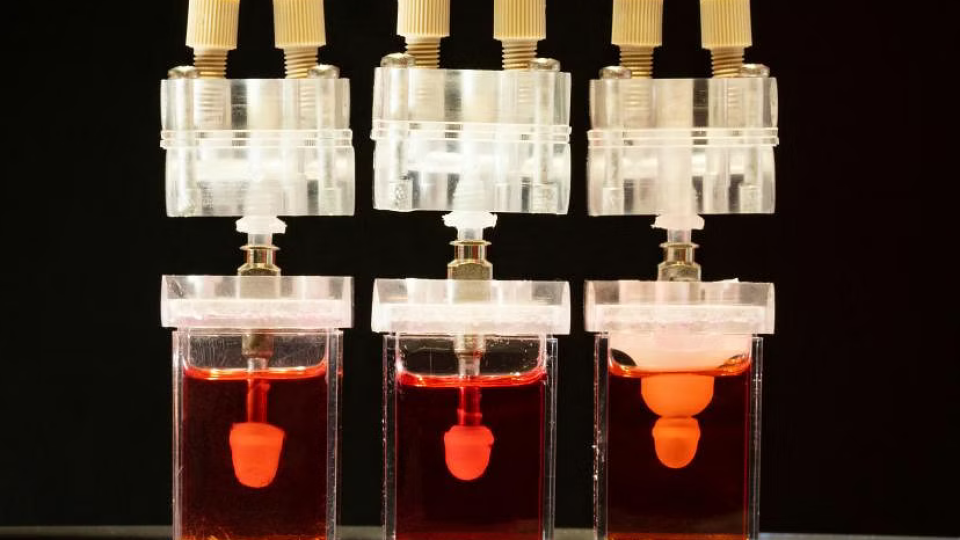December 4, 2023
SINGAPORE – Heart failure is the leading cause of death in Singapore – every day, an average of 34 people have heart attacks and 23 people die from heart disease.
It accounts for 17 per cent of cardiac admissions at the public hospitals here, and with Singapore’s ageing population and increasing prevalence of chronic conditions such as diabetes, obesity and hypertension, the proportion is set to rise.
To test drugs for individual patients, researchers from the National Heart Centre Singapore (NHCS) are working with stem-cell biotechnology company Novoheart to create the world’s first bioengineered Asian patient-specific miniature human heart model with heart failure.
Called Human Heart-in-a-Jar, the models, each the size of a fingertip, are created using stem cells from the blood of patients with heart failure. This allows for personalised drugs to treat the condition and could one day replace animal testing.
Assistant Professor Chrishan Ramachandra, a junior principal investigator at NHCS’ National Heart Research Institute Singapore (NHRIS), said that for some heart diseases, doctors tend to treat them with the same medication.
“The responses (to these generic medication) could be very different. One patient may respond well and another may respond adversely. By making these models, we can have individual ‘hearts’ to test and optimise the best medication for individual patients,” Dr Chrishan said.
NHRIS-NHCS director Derek Hausenloy said: “This whole process of making the stem cells is quite elaborate, and it takes time, (but) we have to bear in mind that the potential benefits of finding a new treatment target that will be broadly applied can result in a bigger impact for heart disease (treatment).”
Dr Chrishan said it was the 2006 groundbreaking discovery by Japanese scientist Shinya Yamanaka that skin cells can be reversed to their embryonic state that allowed for the heart-in-a-jar project to work.
“However, we have moved away from taking skin cells because it is invasive and some patients don’t like it for cosmetic reasons because it leaves a small scar. Instead, we have been taking cells from blood because 5ml of blood is not a big deal for these patients when they come for their checks,” he said.
Like skin cells, blood cells are reversed to their embryonic state and, using stem-cell biotechnology, are turned into beating heart cells.
Professor Hausenloy said the best way to understand a patient’s heart disease is to understand his heart tissue itself.
“Of course, it is not possible to get samples of patients’ heart tissue,” he said. “This approach allows us to recreate or get samples of the ‘heart tissue’ from that particular patient in a dish. Studies have shown that we can mimic or recapitulate the features of that patient’s heart disease in the dish.
“We are quite confident this is an accurate model (that is) able to discover new treatments for a particular heart disease known as heart failure with preserved ejection fraction.” This is a condition where the heart pumps normally but is too stiff to pump enough blood to the rest of the body. The condition accounts for half of all heart failure cases.
Using Novoheart’s 3D miniature human heart technology to make the model, the key characteristics of the failing heart are created.
The cells are then embedded in a hydrogel cast made of collagen and other supporting factors, and the cast is poured into a custom-made mould. The cells will attach to this cast over a couple of days and grow into a hollow, spherical shape, aligning to the mould.
In time, the cells compact the collagen around the mould and become a three-dimensional tissue. The mould is then deflated to leave a hollow, organoid chamber that pumps and beats like a miniature human heart.
“With this heart-in-a-jar approach, it is much more representative of the real setting of the chamber contracting and relaxing. It allows you to then measure the pressures that are developed in the heart, and we hope that this can be a more accurate model of this heart failure disease,” Prof Hausenloy said.
NHCS received a $5 million Industry Alignment Fund – Industry Collaboration Project award from the Agency for Science, Technology and Research to aid and accelerate drug discovery efforts for heart failure in Asian patients.

